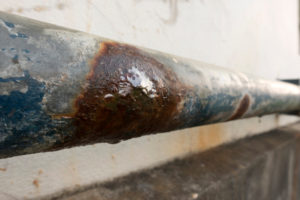This article was originally published on PHCC of MA’s Progress Magazine, Fall 2021 Edition.

High-efficiency, gas-fired appliances are gaining popularity with commercial and residential building owners due to regulations and their affordability and efficiency. However, there is a hidden cost to their high efficiency that installers should be aware of: the heating process produces highly acidic condensate that needs to be properly treated before being discharged into the plumbing system.
Installers are still catching up to the shift to high-efficiency, gas-fired appliances, and many are unaware of the acidic condensate they produce and how to treat it. As a result, there is an emerging acidic condensate problem in America. In fact, based on calculations from AHRI data, high-efficiency condensing appliances expel nearly 9 billion gallons of acidic condensate per year in the US.
Installers can be part of the solution and differentiate themselves as best-in-class service providers by including condensate neutralizers each time they install a condensing appliance.
Neutralizing Acidic Condensate
High-efficiency, gas-fired appliances can extract more energy out of the gas they consume than older appliances. As a result of their condensing phase, these appliances produce condensate as a byproduct, which is designed to collect for treatment via the appliance’s condensate trap. As condensing appliances are relatively new on the market, many of the installations are incomplete, given the acidic condensate is often discharged directly into plumbing systems or directly into the environment.
This acidic condensate, when left untreated, can damage property and infrastructure. To provide a snapshot, acidic condensate from condensing heating appliances can destroy iron or copper pipes in a matter of months. Without proper treatment, drains and concrete foundations will corrode, and groundwater and septic systems will be polluted.

While regulations around untreated acidic condensate tend to be fragmented at the municipal and regional level, the International Plumbing Code considers condensate neutralizers a requirement for installing equipment that produces acidic condensate (1). Additionally, the Environmental Protection Agency prohibits the discharge of corrosive pollutants (2).
- International Plumbing Code (Section 803.1) https://codes.iccsafe.org/content/IPC2021P1/chapter-8-indirect-special-waste#IPC2021P1_Ch08_Sec8032
- Environmental Protection Agency (Section 403.5(b)(2)) https://www.govinfo.gov/content/pkg/CFR-2020-title40-vol31/pdf/CFR-2020-title40-vol31-sec403-5.pdf
Ensuring that condensate neutralizers are part of every install is essential for today’s high-efficiency, gas-fired appliances.
How Condensate Neutralizers Work
Condensate neutralizers raise the pH level of the condensate so that it can safely be discharged into the wastewater. Each device is filled with neutralizing media, such as magnesium hydroxide.
The neutralization process is as follows:
- Acidic concentrate from the appliance slowly enters the neutralizer, making contact with the media, beginning its “soak time”
- The media reacts with the condensate to raise the pH level and neutralize the condensate (to 5.0-9.5 pH)
- Once neutralized, the condensate is safe to be released into the wastewater system
Installers should consider a few key characteristics when selecting a condensate neutralizer to ensure that it works effectively:
- The condensate neutralizer should be designed for your application. There are various types that are suited for heating and plumbing conditions, and for residential and commercial applications.
- The condensate neutralizer should be properly sized to the appliance. This is dependent on a number of factors, including the BTU input of the appliance, heating days, system design, raw gas composition, and operating hours.
- The neutralizer design should ensure proper “soak time” to maximize contact with the neutralizing media.
Installers Are Key to Solving America’s Acidic Condensate Problem
When installers include a condensate neutralizer with every condensing appliance, they can play a critical role in solving America’s emerging acidic condensate problem. They have an opportunity to make a difference in the industry and position themselves as a best-in-class service provider, educating customers about the importance of making condensate safe before releasing it into the wastewater system.
There’s also the financial upside to consider. Just as conventional heating and plumbing appliances require maintenance, high-efficiency, gas-fired appliances should receive routine maintenance. This includes recurring neutralizer media refills to ensure continued protection throughout the lifespan of the appliance.
Installers can save customers from expensive property damage caused by acidic condensate with the complete installation required for condensing appliances. Additionally, many property owners upgrade to high-efficiency appliances to reduce their environmental impact—without a condensate neutralizer, the appliance can’t live up to its environmental promise.
There are many benefits to consider, for the industry and the environment, when installers champion condensate neutralizers.